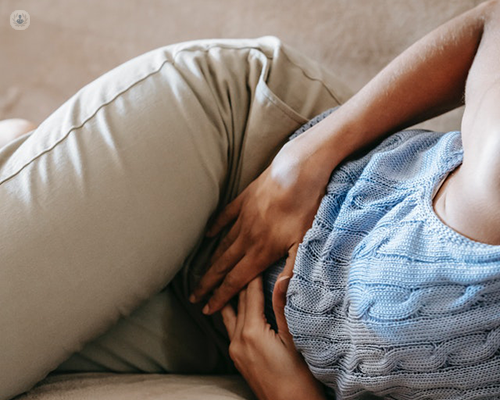Diagnostic laparoscopy: what to expect
Written by:Diagnostic laparoscopy is a procedure carried out under general anaesthetic to try and establish and perhaps also treat the cause of a patient’s symptoms of abdominal pain. A keyhole (laparoscopic) camera is inserted through a small incision, close to the belly button to identify any abnormalities within the abdomen and pelvis. In this article, highly experienced consultant laparoscopic, general and colorectal surgeon Mr Dominic Coull expertly outlines what patients can expect from the procedure.

What are the benefits of diagnostic laparoscopy?
The procedure offers the opportunity to identify and hopefully treat the previously unidentified cause of abdominal or pelvic pain. It allows a closer inspection of a lump or abnormal fluid that has been previously seen on a scan, helping to accurately diagnose tumours, ovarian cysts or pelvic infections.
It also allows assessment of chronic conditions such as Crohn’s disease, diverticular disease and endometriosis. If the cause of pain is scar tissue (adhesions) the operation will offer an opportunity for the surgeon to divide the adhesions, thus stopping the pain.
If the diagnostic laparoscopy doesn’t identify a cause of your symptoms, this reassures that there is no hidden sinister problem behind them. Around thirty per cent of patients attending hospital with abdominal pain and symptoms are diagnosed with non-specific abdominal pain which in eighty per cent of cases resolve themselves in the fullness of time.
Are there any alternatives to diagnostic laparoscopy?
The abdomen and pelvis can also be visualised with detailed scans such as CT and MRI. CT scans involve a significant amount of radiation and some patients are too claustrophobic to go in an enclosed MRI scanner. These scans are unable to identify every cause of abdominal pain and sometimes a diagnostic laparoscopy will still be necessary.
What does a diagnostic laparoscopy involve?
The operation is performed under general anaesthesia and usually takes thirty to sixty minutes. Your bladder may be emptied using a urinary catheter at the start of the operation. The surgeon will shave your abdomen at the time of surgery and you will also have a rectangular area of one thigh shaved to facilitate the safe usage of a surgical electrocautery device.
A keyhole (laparoscopic) camera is inserted through a small incision, close to the belly button and the abdominal cavity is then inflated with CO2 to give an optimal view of its contents, allowing the specialist to identify any abnormalities within the abdomen and pelvis. The surgeon will usually make one or two more small incisions to allow the entry of surgical instruments to perform the operation.
How can I optimise the chances of my successful surgery?
Patients should stop smoking completely for at least 2 weeks before surgery to reduce their risk of complications. Being overweight will increase your risk of complications but thirty minutes of exercise three times a week prior to surgery will improve your ability to cope with the anaesthetic.
What is the recovery period like after a diagnostic laparoscopy?
The day after surgery, patients could take a short walk if they feel comfortable without putting excessive strain on the wound. Driving and drinking alcohol should be avoided for the first twenty-four hours after the procedure. Surgeons usually apply surgical glue to most wounds which means that you can safely shower or bath from the day after surgery. They will also likely prescribe a pain killer to reduce any discomfort at the incision site.
If you develop any of the following symptoms after being discharged, you should contact your hospital urgently:
- increasing pain
- fever
- vomiting
- inability to pass urine or stools
If you would like to book an appointment with Mr Coull to discuss abdominal pain or the diagnostic laparoscopic procedure, you can do so by visiting his Top Doctors profile.


